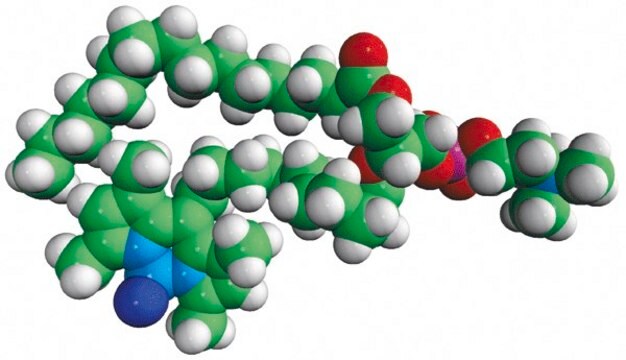810335C
Avanti
18:1 Cyanine 5 PE
Avanti Research™ - A Croda Brand
Sinonimo/i:
1,2-dioleoyl-sn-glycero-3-phosphoethanolamine-N-(Cyanine 5)
Scegli un formato
Scegli un formato
About This Item
Prodotti consigliati
Saggio
>99% (TLC)
Stato
liquid
Confezionamento
pkg of 1 × 1 mL (810335C-1mg)
pkg of 5 × 1 mL (810335C-5mg)
Produttore/marchio commerciale
Avanti Research™ - A Croda Brand
Concentrazione
1 mg/mL (810335C-1mg)
1 mg/mL (810335C-5mg)
Condizioni di spedizione
dry ice
Temperatura di conservazione
−20°C
Applicazioni
- as a standard for the estimation of absolute density of Cy5 labeled Trx-His6-NCav-CT on supported lipid bilayers (SLB)[1]
- in annexin-coated vesicle production[2]
- to label vesicle types in order to optically distinguish them from other vesicles and to initiate biochemical reactions in a cell-mimetic compartment[3]
Azioni biochim/fisiol
Confezionamento
Note legali
Avvertenze
Danger
Indicazioni di pericolo
Classi di pericolo
Acute Tox. 3 Inhalation - Acute Tox. 4 Oral - Aquatic Chronic 3 - Carc. 2 - Eye Irrit. 2 - Repr. 2 - Skin Irrit. 2 - STOT RE 1 - STOT SE 3
Organi bersaglio
Central nervous system, Liver,Kidney
Codice della classe di stoccaggio
6.1D - Non-combustible acute toxic Cat.3 / toxic hazardous materials or hazardous materials causing chronic effects
Classe di pericolosità dell'acqua (WGK)
WGK 3
Punto d’infiammabilità (°F)
does not flash
Punto d’infiammabilità (°C)
does not flash
Scegli una delle versioni più recenti:
Certificati d'analisi (COA)
It looks like we've run into a problem, but you can still download Certificates of Analysis from our Documenti section.
Se ti serve aiuto, non esitare a contattarci Servizio Clienti
Possiedi già questo prodotto?
I documenti relativi ai prodotti acquistati recentemente sono disponibili nell’Archivio dei documenti.
Il team dei nostri ricercatori vanta grande esperienza in tutte le aree della ricerca quali Life Science, scienza dei materiali, sintesi chimica, cromatografia, discipline analitiche, ecc..
Contatta l'Assistenza Tecnica.









